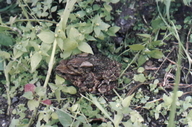|
Duttaphrynus himalayanus (Günther, 1864)
Himalayan Toad | family: Bufonidae genus: Duttaphrynus |
 © 2001 Karan B. Shah, Nepal Nat. Hist. Mus. (1 of 4)
|
|
|
|
Description Snout-vent length 130-132 mm. Color: Uniform brown. Cranial crest and tips of digits dark brown. Distribution and Habitat Country distribution from AmphibiaWeb's database: Bhutan, China, India, Nepal, Pakistan
Life History, Abundance, Activity, and Special Behaviors Breeding activity starts after a downpour, during May-July; males croak in low tone with "curr, curr" repeated several times. Eggs are laid in a double string of jelly in shallow pools along torrents. The toad hibernates during the winter under stones and in fissures in the ground from September to March. The karyotype number recorded for this species is 22 (Chatterjii and Barik, 1970). Larva The tadpoles are found, at a high elevation in the Himalayan range, in small, calm pools along torrents, with algal vegetation. Total length of tadpole 28-30; tail 19-20 mm. Trends and Threats Possible reasons for amphibian decline Prolonged drought Comments This species was highlighted in News of the Week: January 8, 2018: Biodiversity survey work is a critical step to assess and monitor the state of amphibians in any given area, even protected ones. A herpetology survey conducted by Shrestha and Shah (2017) in Manaslu Conservation Area in western Nepal along the China border illustrates this in a multi-pronged strategy. Their survey included traditional methods such as literature review, visual encounter surveys, patch sampling and opportunistic observations combined with less commonly used ethnographic questionnaire. Of the 21 species documented by the literature, they found 5 species including a new record for the area. Of the 8 species of documented amphibians, only Duttaphrynus himalayanus was encountered in the field; three frog species were noted in interviews as popular food items. The authors note this local ‘delicacy’ could have significant impact on biodiversity and show how taking into account human use is an important part of survey work. (Written by Michelle Koo) Originally submitted by: M. S. Khan (first posted 2000-08-30) Life history by: Michelle S. Koo (updated 2021-03-18)
Edited by: Michelle S. Koo, Joyce Gross (2023-08-04) Species Account Citation: AmphibiaWeb 2023 Duttaphrynus himalayanus: Himalayan Toad <https://amphibiaweb.org/species/193> University of California, Berkeley, CA, USA. Accessed May 27, 2025.
Feedback or comments about this page.
Citation: AmphibiaWeb. 2025. <https://amphibiaweb.org> University of California, Berkeley, CA, USA. Accessed 27 May 2025. AmphibiaWeb's policy on data use. |




 Map of Life
Map of Life